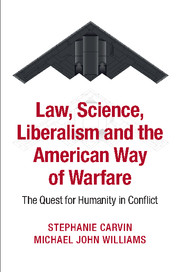Book contents
- Frontmatter
- Contents
- Prologue
- Introduction
- 1 Law and science in the Western way of war
- 2 The American way of war
- 3 Vietnam and the “science” of war
- 4 Immaculate destruction: reorganization, revolution and re-enchantment of War
- 5 Revolution denied: the “war” on terror
- 6 Back to the future?
- Index
- References
6 - Back to the future?
Published online by Cambridge University Press: 05 December 2014
- Frontmatter
- Contents
- Prologue
- Introduction
- 1 Law and science in the Western way of war
- 2 The American way of war
- 3 Vietnam and the “science” of war
- 4 Immaculate destruction: reorganization, revolution and re-enchantment of War
- 5 Revolution denied: the “war” on terror
- 6 Back to the future?
- Index
- References
Summary
Reportedly fed up with complicated and protracted operations overseas, top Pentagon officials acknowledged this week they were desperate to be given just one straightforward, no-nonsense military engagement they could really knock out of the park.
“Given all these messy, ambiguous conflicts we’ve been fighting against enemies you can’t even put your finger on, what we could really use right now is a plain old war against a clear-cut bad guy employing conventional tactics and weaponry,” said Gen. Martin Dempsey, chairman of the Joint Chiefs of Staff. “No roadside bombs or plainclothes militants hiding out among innocent civilians – just a fair fight where two sides shoot at each other and someone wins. That’s it.”
Citing the country’s long history of winning wars against sovereign nations with actual standing armies, the Pentagon’s top brass repeatedly assured reporters they would “completely wipe the floor” with such an opponent if given the chance, and promised they would make America “very, very proud.”
The Onion, March 28, 2012The story of the United States at war is a tale of a country greatly influenced by its liberal political culture, geographic position and history. The United States uniquely adapted a specific Western way of war, starting in the early days of the republic, to wage war in a manner compatible with its liberal norms. Isolated geographically, and with a history of military engagements conceptualized as “all or nothing struggles,” the American people, American politicians and the American military developed a view of war as an aberration – a necessary struggle to be won quickly, but to also be won in a more or less humane way. A liberal nation, enthralled with science and technology, it has sought to apply its technological prowess to achieve this goal. This has worked in some cases, principally where the opponent fights by the same normative standards, but it has failed spectacularly in others, mainly those that are inter-cultural in nature. Today’s challenges, and those of the medium term, are no different.
- Type
- Chapter
- Information
- Law, Science, Liberalism and the American Way of WarfareThe Quest for Humanity in Conflict, pp. 201 - 214Publisher: Cambridge University PressPrint publication year: 2014



